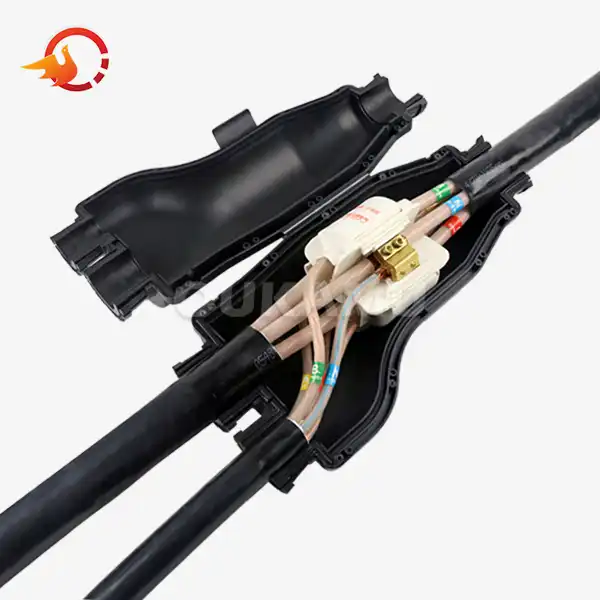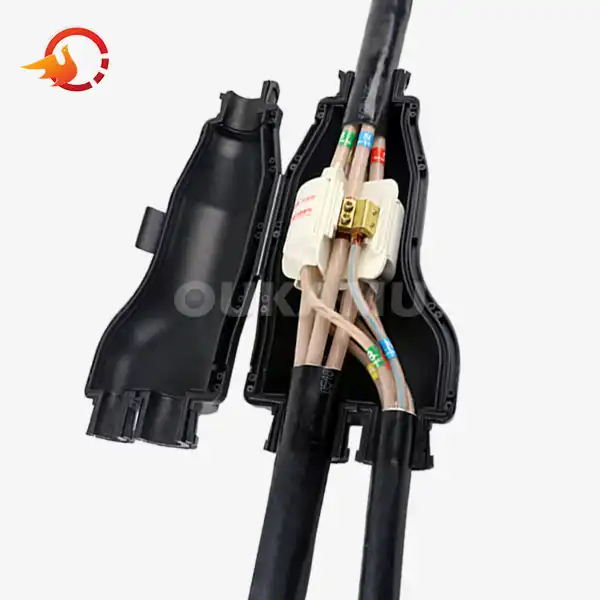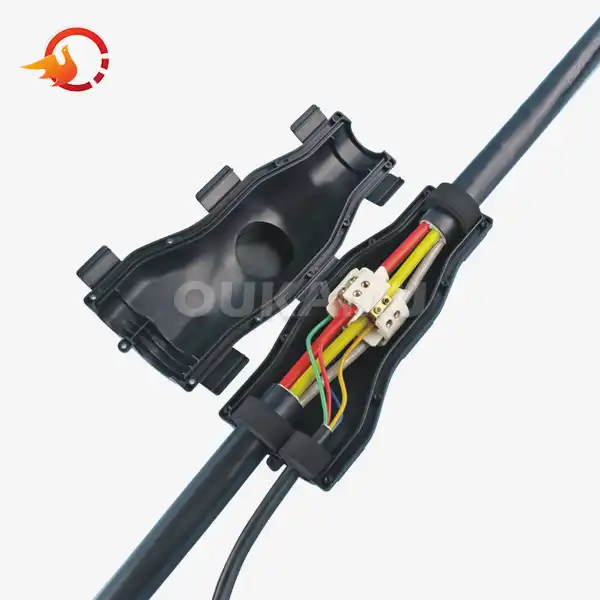Which Insulation Material Works Best for Power Cable Joints?
 2025-08-14 10:44:46
View:389
2025-08-14 10:44:46
View:389Power cable joints play a crucial role in electrical systems, connecting cable sections and ensuring the uninterrupted flow of electricity. The insulation material used in these joints is paramount to their performance, durability, and safety. This comprehensive guide explores the various insulation materials available for power cable joints, their properties, and how to select the optimal insulation for your specific application.
Comparing Insulation Materials for Durable Cable Joints
When it comes to power cable joints, the choice of insulation material can significantly impact the overall system performance. Let's examine some of the most common insulation materials used in the industry:
XLPE (Cross-Linked Polyethylene)
XLPE is a popular choice for medium and high-voltage cable joints due to its excellent electrical properties and thermal stability. This material offers:
- High dielectric strength
- Low electrical losses
- Resistance to thermal aging
- Good mechanical properties
XLPE insulation is particularly suitable for applications requiring long-term reliability and performance under varying temperature conditions.
EPR (Ethylene Propylene Rubber)
EPR is another widely used insulation material, known for its flexibility and resistance to environmental factors. Key advantages include:
- Excellent moisture resistance
- Good flexibility, even at low temperatures
- High ozone and corona resistance
- Suitable for both indoor and outdoor applications
EPR insulation is often chosen for cable joints in harsh environments or where flexibility is a crucial factor.
EPDM (Ethylene Propylene Diene Monomer)
EPDM is a synthetic rubber with properties similar to EPR but with enhanced weather resistance. It offers:
- Excellent resistance to weathering and UV radiation
- Good electrical properties
- High flexibility and elongation
- Resistance to heat aging
EPDM is often used in outdoor cable joint applications where exposure to the elements is a concern.
Silicone Rubber
Silicone rubber insulation is known for its exceptional performance in extreme temperature conditions. Its benefits include:
- Wide operating temperature range (-55°C to +200°C)
- Excellent electrical properties
- Good resistance to corona and ozone
- Low moisture absorption
Silicone rubber is often chosen for cable joints in applications with extreme temperature variations or where fire resistance is required.
How Cable Joint Insulation Affects Performance and Safety?
The insulation material used in power cable joints plays a critical role in ensuring the safety and reliability of electrical systems. Here's how different aspects of insulation affect performance:
Electrical Properties
The primary function of insulation in cable joints is to prevent current leakage and maintain electrical integrity. Key electrical properties include:
- Dielectric strength: The ability to withstand high voltage without breakdown
- Volume resistivity: Resistance to current flow through the insulation
- Permittivity: The material's ability to store electrical energy
Higher dielectric strength and volume resistivity contribute to better insulation performance and reduced risk of electrical failures.
Thermal Characteristics
Cable joints often operate in environments with fluctuating temperatures. The insulation material's thermal properties are crucial for long-term reliability:
- Thermal conductivity: Ability to dissipate heat generated during operation
- Thermal expansion coefficient: How the material expands or contracts with temperature changes
- Maximum operating temperature: The highest temperature at which the insulation can perform reliably
Materials with good thermal stability and heat dissipation properties help prevent overheating and extend the lifespan of cable joints.
Mechanical Properties
Cable joints may be subjected to various mechanical stresses during installation and operation. Important mechanical properties include:
- Tensile strength: Resistance to stretching and breaking
- Elongation: Ability to stretch without breaking
- Compression set: Ability to return to original shape after compression
Insulation materials with good mechanical properties can withstand physical stresses and maintain their integrity over time.
Environmental Resistance
Depending on the application, powder cable joints may be exposed to various environmental factors. Resistance to these factors is crucial for long-term performance:
- Moisture resistance: Ability to prevent water ingress and maintain electrical properties
- UV resistance: Protection against degradation from sunlight exposure
- Chemical resistance: Ability to withstand exposure to oils, solvents, and other chemicals
- Ozone and corona resistance: Protection against breakdown from electrical discharges
Choosing insulation materials with appropriate environmental resistance ensures the longevity and reliability of cable joints in diverse operating conditions.
Choosing the Right Insulation for Different Cable Joints
Selecting the optimal insulation material for power cable joints requires careful consideration of various factors. Here's a guide to help you make informed decisions:
Voltage Rating
The voltage rating of the cable system is a primary factor in choosing insulation materials:
- Low voltage (up to 1kV): XLPE, EPR, and PVC are commonly used
- Medium voltage (1kV to 33kV): XLPE and EPR are preferred for their superior electrical properties
- High voltage (above 33kV): XLPE is often the material of choice due to its excellent dielectric strength and thermal stability
Ensure that the selected insulation material is rated for the maximum operating voltage of your system.
Installation Environment
Consider the conditions where the cable joint will be installed and operated:
- Indoor applications: XLPE, EPR, and PVC are suitable for most indoor environments
- Outdoor applications: EPDM, silicone rubber, or specially formulated XLPE compounds offer better weather resistance
- Underground installations: Materials with excellent moisture resistance and mechanical strength, such as XLPE or EPR with additional water-blocking features, are recommended
- Industrial environments: Choose materials with good chemical resistance, such as EPDM or specially formulated compounds
Matching the insulation material to the specific environmental challenges ensures optimal performance and longevity.
Temperature Considerations
Different insulation materials have varying temperature ratings and thermal properties:
- For high-temperature applications: Silicone rubber or specially formulated XLPE compounds are suitable
- For low-temperature environments: EPR and EPDM maintain good flexibility at lower temperatures
- For applications with wide temperature fluctuations: Silicone rubber or materials with low thermal expansion coefficients are recommended
Choose insulation materials that can withstand the expected temperature range in your application.
Mechanical Stress
Consider the physical stresses the cable joint may encounter:
- For applications with frequent movement or vibration: EPR or EPDM offer good flexibility and resilience
- For static installations with minimal movement: XLPE provides excellent stability and long-term performance
- For installations requiring high tensile strength: Reinforced insulation materials or additional mechanical protection may be necessary
Matching the insulation's mechanical properties to the expected stresses helps prevent premature failure and ensures long-term reliability.
Ease of Installation
The installation process can impact the choice of insulation material:
- Heat-shrink materials: Offer convenience and adaptability to various cable sizes
- Cold-shrink materials: Provide quick installation without the need for heat sources
- Tape-based systems: Allow for customization and flexibility in complex joint configurations
Consider the skills of your installation team and the availability of equipment when selecting insulation materials.
Long-Term Performance and Maintenance
Evaluate the long-term characteristics of different insulation materials:
- Aging resistance: XLPE and silicone rubber generally offer excellent long-term stability
- Moisture resistance: EPDM and specially formulated compounds provide superior protection against water ingress
- Ease of repair: Some materials, like certain tape-based systems, may be easier to repair or modify in the field
Consider the expected lifespan of your installation and any potential maintenance requirements when choosing insulation materials.
Cost Considerations
While performance should be the primary concern, cost is also a factor:
- Initial material cost: Some high-performance materials may have higher upfront costs
- Installation cost: Consider the time and labor required for different insulation types
- Long-term cost: Factor in the potential for reduced maintenance and longer service life with higher-quality materials
Evaluate the total cost of ownership, including installation, maintenance, and potential replacement costs, when making your decision.
Regulatory Compliance
Ensure that the chosen insulation material meets all relevant standards and regulations:
- International standards: IEC, IEEE, or CENELEC specifications for cable accessories
- Regional or national requirements: Specific regulations for fire safety, environmental impact, or performance criteria
- Industry-specific standards: Additional requirements for sectors like oil and gas, nuclear, or renewable energy
Compliance with applicable standards ensures the safety, reliability, and legal conformity of your cable joint installation.
Conclusion
Selecting the right insulation material for power cable joints is a critical decision that impacts the safety, reliability, and performance of electrical systems. By carefully considering factors such as voltage rating, environmental conditions, temperature requirements, and mechanical stresses, you can choose the optimal insulation material for your specific application.
Remember that while this guide provides a comprehensive overview, each project may have unique requirements. For expert advice on selecting the best insulation material for your power cable joints, don't hesitate to reach out to the specialists at Xi'an Oukamu Electric Co., Ltd. With 17 years of experience in cable connection technology, we can provide tailored solutions to meet your specific needs. Contact us at info@okmbranchcable.com for personalized assistance and cutting-edge cable joint products.
FAQ
Q: What is the most important factor in choosing insulation for power cable joints?
A: The most critical factor is typically the voltage rating of the system. However, environmental conditions, temperature requirements, and mechanical stresses also play significant roles in the selection process.
Q: Can I use the same insulation material for all types of cable joints?
A: While some materials like XLPE are versatile, it's generally best to select insulation materials based on the specific requirements of each application. Different environments and operating conditions may call for different insulation types.
Q: How often should cable joint insulation be inspected or replaced?
A: The inspection and replacement frequency depends on various factors, including the operating environment, voltage stress, and the specific insulation material used. Generally, regular visual inspections are recommended, with more thorough assessments performed every 3-5 years or as specified by the manufacturer.
References
1. Smith, J.A. (2020). "Advanced Insulation Materials for High-Voltage Cable Joints." IEEE Transactions on Dielectrics and Electrical Insulation, 27(5), 1456-1469.
2. Johnson, M.R. & Brown, L.K. (2019). "Comparative Analysis of XLPE and EPR Insulations in Medium Voltage Cable Accessories." International Journal of Electrical Power & Energy Systems, 112, 762-775.
3. Yamamoto, H., et al. (2021). "Long-term Performance of Silicone Rubber Insulation in Extreme Temperature Conditions." Polymer Testing, 93, 106878.
4. Garcia-Souto, J.A. & Lamela-Rivera, H. (2018). "Review on Insulation Monitoring of Power Cables." Measurement Science and Technology, 29(4), 042001.
5. Electrical Power Research Institute (EPRI). (2017). "Cable System Aging Management: Best Practices for Electric Utilities." EPRI Technical Report 3002010403.















